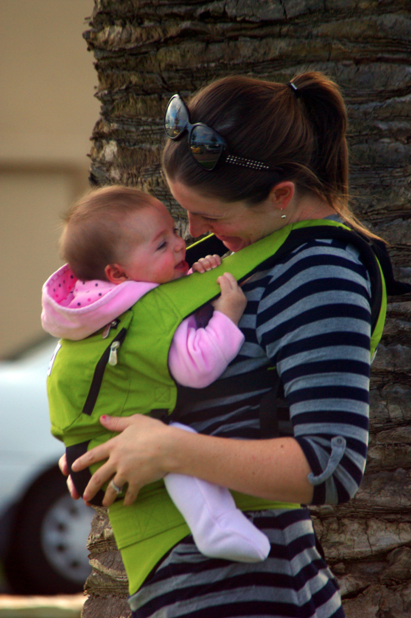
Choosing a baby carrier can be a complicated venture. How to choose a baby carrier for a newborn vs. how to choose one for an older baby is different because different ages have different needs. Newborns want to be snuggled up against you, like how they were in utero, while older babies want to sit up and look at the world around them. But no matter your child’s age, when choosing a baby carrier, you want to choose an ergonomic baby carrier.
The Significance and Considerations of an Ergonomic Baby Carrier
Ergonomics is something every parent needs to consider when choosing a baby carrier. Not only do you want your baby to be snuggled up close to you, but you also want to make sure they are correctly supported and positioned in the baby carrier. As a chiropractor I can’t stress enough how important it is that your baby’s spine, pelvis and hips are well supported in their baby carrier as well as how the carrier sits on your body. The baby carrier also needs to be something that will be comfortable for both of you, especially if you are wearing a larger baby or even your toddler.
For your baby’s spine to be correctly supported they should not be held in an overly upright position, instead be gently held in the natural “C” curve that they have been used to for nine months in-utero. When a baby’s spine is held in a more upright position, which is especially seen in a “forward facing-out” style carrier, the stress that is placed on the baby’s lower spine can be immense. Since an infant’s lower spine has yet to develop the lumbar curvature, most of the pressure from being held in an upright posture will be directed through their lower spine, pelvis and hip joints, which are particularly vulnerable at this young age. The preferred way for your baby to sit in a baby carrier is with their bottom lower than their knees, their hips spread out over 90 degrees and their knees flexed. This is sometimes referred to as the “M” position. This position ensures your baby’s hips are kept firmly within the hip socket and their weight is evenly distributed. Upright or “forward facing-out” carriers can place a lot of stress from the baby’s weight through their hip joints, which is of particular concern if the baby has “clicky hips” or has been diagnosed with a hip condition such as hip dysplasia. This is one of the main reasons that I do not recommend a “forward facing-out” carrier for parents to use with their babies at any age.
The next main consideration is how well the carrier distributes the weight of the baby on the wearer. What to look for is a carrier that holds your baby in nice and close to your body, rather than one that allows your baby to lean away. This is particularly important if you have pre-existing lower back issues as you don’t want to be leaning backwards to compensate for this. The Ergobaby range is designed to hold your baby in close, therefore minimising the strain on your body. Their range also has a thick padded waist strap and padded shoulder straps with a chest buckle that helps to disperse the carrying weight of the baby appropriately on you, the wearer.
The best thing about the Ergobaby range is that it allows that special bond between baby and wearer whilst you can be confident you are maintaining safe and correct positioning for both your baby and yourself.
Read my reviews of the Ergobaby Performance Carrier here and the Sport Carrier here.
References
1. Archer, J. (1992). Ethology and Human Development. Rowman.
2. Wall-Scheffler C, Geiger K, Steudel-Numbers K. Infant carrying: The role of increased locomotory costs in early tool development. Am. J. Phys. Anthropol. 2007; 133: 841–846. doi: 10.1002/ajpa.20603 (16%)
3. http://welladjustedbabies.com/are-baby-carriers-safe/#ixzz1vPLiI3hX
4. Baby Wearing – Suggestions for Carrying Your Baby: A Chiropractic Perspective; Jeanne Ohm, DC; ICPA, Pathways to Family Wellness, Issue #1
5. Bonnet, E.. (1998 ). In Points made during discussions regarding the carrying of Infants and small children, Published in Krankengymnastik 50 Jg (1998) No.8
6. International Chiropractic Pediatric Association. Baby Wearing: Suggestions for Carrying your Baby.http://www.icpa4kids.org/research/children/babywearing.html
7. Kirkilionis, E. (2002). Carrying an Infant:More than the Possibility of Child Transport. Kosel.http://www.babywearingschool.com/drkirkilionis.htm
8. Le Veau, B.. (1984, Dec). Developmental Biomechanics: Effect of Forces on the Growth, Development, and Maintenance of the Human. Physical Therapy. www.physicaltherapyjournal.com/cgi/content/abstract/64/12/1874
9. Morningstar. (2005). Reflex Control of the Spine and Posture: A Review of the Literature from a Chiropractic Perspective.
Chiropractic & Osteopathy. www.ncbi.nlm.nih.gov/pubmed/16091134
10. Rowe, Y. (1987). ESSENTIAL SKELETAL RADIOLOGY. Baltimore: Williams and Wilkins.




